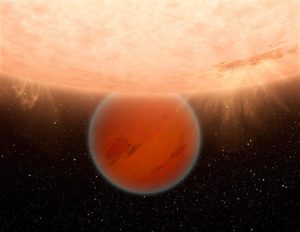Newborn planet found orbiting young star, defying planet formation timeline:
This newborn planet, predicted to be 10 to 20 times the mass of Earth, is one of the most recently discovered exoplanets outside our solar system. It coexists with the leftovers of the protoplanetary disc, a disc of dense gas and dust that surrounded the host star and provided the materials for the planet’s formation.
It is believed that the star it circles will evolve into an orange dwarf star, which is less hot and less massive than our sun. The star has roughly 70% the mass of the sun and half the luminosity. It is approximately 520 light years away from Earth in our Milky Way galaxy. A light-year is the distance that light travels in a year (5.9 trillion miles 9.5 trillion km).

“This discovery confirms that planets can be in a cohesive form within 3 million years, which was previously unknown because Earth took 10 to 20 million years to form,” said Madyson Barber, a graduate student in the department of physics and astronomy at the University of North Carolina at Chapel Hill and lead author of the study published this week in the journal Nature.
“We don’t really know how long it takes for planets to form,” says UNC astrophysicist and research co-author Andrew Mann. “We understand that massive planets must form quicker than their disc dissipates because they require a large amount of gas from the disc. However, discs take between 5 and 10 million years to evaporate. So, do planets develop in one million years? 5?
The planet, named IRAS 04125+2902 b and TIDYE-1b, orbits its star every 8.8 days at a distance roughly one-fifth that of our solar system’s innermost planet Mercury from the sun. Its mass falls somewhere between that of Earth, the largest of our solar system’s rocky planets, and Neptune, the smallest of the gas planets. It is less dense than Earth and has a diameter that is approximately 11 times larger. Its chemical makeup is unknown.
The researchers believe the planet formed further away from its star and then moved inward.
“Forming huge planets close to the star is challenging since the protoplanetary disc shrinks away from closest to the star the fastest, meaning there isn’t enough material to form a large planet.
The astronomers discovered it using the “transit” approach, which involves measuring a decrease in the brightness of the host star when the planet passes in front of it from Earth’s perspective. It was discovered by NASA’s TESS space telescope.
“This is the youngest known transiting planet. “It is comparable to the youngest planets known,” Barber added.
Exoplanets that were not found using this method are sometimes observed directly with telescopes. However, these are often huge, roughly ten times the size of Jupiter, the largest planet in our solar system.
Stars and planets develop from interstellar gas and dust.
To form a star-planet system, the cloud of gas and dust will collapse and spin into a flat environment, with the star at the center and the disk surrounding it. Planets will form in that disk. The disk will then dissipate starting from the inner region near the star,” Barber said.
“It was previously thought that we wouldn’t be able to find a transiting planet this young because the disk would be in the way. But for some reason that we aren’t sure of, the outer disk is warped, leaving a perfect window to the star and allowing us to detect the transit,” Barber added.





